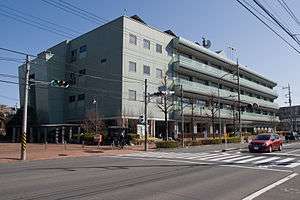Aoba-ku, Yokohama
Aoba-ku (青葉区) is one of the 18 wards of the city of Yokohama in Kanagawa Prefecture, Japan. As of 2010, the ward had an estimated population of 302,643 and a density of 8,610 persons per km². The total area was 35.14 km².
Aoba 青葉区 | |
|---|---|
| Aoba Ward | |
 Flag | |

| |
Location of Aoba in Kanagawa | |
 Aoba | |
| Coordinates: 35°33′10″N 139°32′14″E | |
| Country | Japan |
| Region | Kantō |
| Prefecture | Kanagawa |
| City | Yokohama |
| Area | |
| • Total | 35.14 km2 (13.57 sq mi) |
| Population (February 2010) | |
| • Total | 302,643 |
| • Density | 8,610/km2 (22,300/sq mi) |
| Time zone | UTC+9 (Japan Standard Time) |
| - Tree | Yamazakura |
| - Flower | Nashi Pear |
| Address | 31-4 Ichigao-chō, Aoba-ku Yokohama-shi, Kanagawa-ken 225-0024 |
| Website | Aoba Ward Office |

Geography
Aoba is located in eastern Kanagawa Prefecture, and in the northwest corner of the city of Yokohama. The area is largely flatland, with scattered small hills.
Surrounding municipalities
History
The area around present-day Aoba Ward was formerly part of Tsutsuki District in Musashi Province. During the Edo period, it was a rural region classified as tenryō territory controlled directly by the Tokugawa shogunate, but administered through various hatamoto. After the Meiji Restoration, the area became part of the new Kanagawa Prefecture in 1868. In the cadastral reform of April 1, 1889, the area was divided into the villages of Tana, Nakazato and Yamauchi in Tsuzuki District (都筑郡田奈村, 中里村, 山内村, Tsuzuki-gun Tana-mura, Nakazato-mura, Yamauchi-mura). During the Meiji period, the area was a center for sericulture. On April 1, 1939, the three villages within Tsutsuki District were annexed by the neighboring city of Yokohama, becoming part of Kōhoku-ku.
In a major administrative reorganization of October 1, 1969, Kōhoku Ward was divided, and the present-day area of Aoba Ward became part of the new Midori-ku. On November 6, 1994, Kōhoku and Midori Wards were recombined, then re-divided into four new Wards (Kōhoku, Midori, Tsuzuki and Aoba). The North Branch of the Midori Ward Office in Ichigao became the new Aoba Ward Office. The division and re-division of Wards has much to do with the development of northern Yokohama by railroad companies. The opening of the Tōkyū Den-en-toshi Line and associated "Tama Den-en-toshi" (東急多摩田園都市, Tōkyū Tama Den'en-toshi) residential communities led to the rapid suburban development in this region. This was followed by the Kōhoku New Town (港北ニュータウン, Kōhoku Nyūtaun) project in the 1980s and early 1990s. The core of the Kōhoku New Town became a significant commercial centre once the subway line extension between Shin-Yokohama and Azamino was completed in 1993. The influx of new population resulted in the entire “Kōhoku New Town” being re-organized into the new Tsuzuki Ward.
Emblem of Aoba Ward
The emblem of Aoba Ward was officially announced on November 6, 1996, to commemorate the birth of Aoba Ward. The emblem was chosen from a number of designs submitted by residents. The trees and different shapes inside the green oval spell "AOBA." The hill symbolizes the geographic location of Aoba Ward. This emblem signifies the warmth that the nature gives to human beings.
Economy
Aoba Ward is largely a regional commercial center and bedroom community for central Yokohama, Kawasaki and Tokyo. The major commercial centres are around the Aobadai (青葉台, Aoba-dai) and Tama Plaza (たまプラーザ, Tama Purāza) stations. The far-northern end of Aoba and the Yamoto River (谷本川, Yamoto-gawa) valley area retained some residual agriculture into the 1990s, when real-estate developers converted much of the farmlands and orchards into subdivisions and condominiums.
Transportation
Railways
Prefecture roads
- Kanagawa Prefecture Road 12
- Kanagawa Prefecture Road 13
- Kanagawa Prefecture Road 102
- Kanagawa Prefecture Road 139
- Kanagawa Prefecture Road 140
Education
Local attractions
Noted people from Aoba Ward
- Tomoya Nagase, singer, actor
- Hiroshi Nakada, politician
- Emi Wakui, actress
References
- Kato, Yuzo. Yokohama Past and Present. Yokohama City University (1990).
External links
- Aoba Ward Office
- City of Yokohama statistics

| Wikimedia Commons has media related to Aoba-ku, Yokohama. |